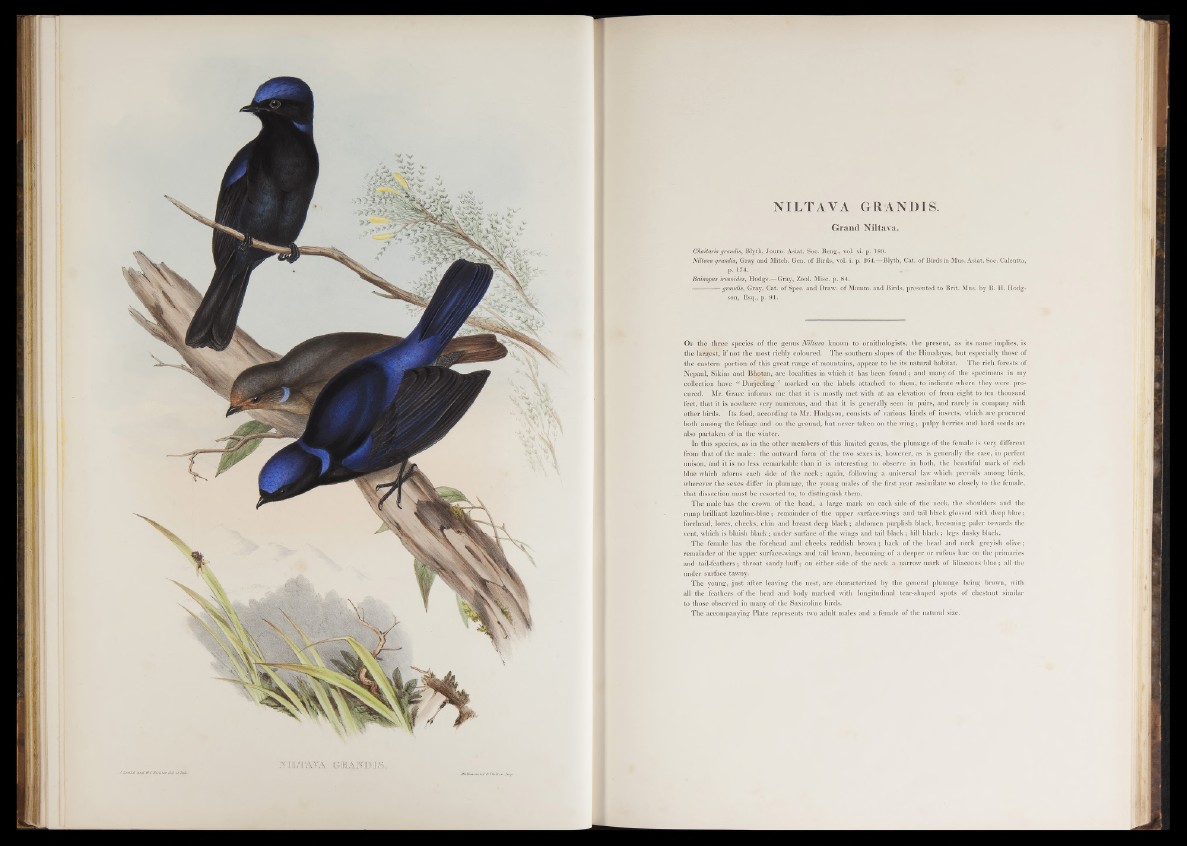
NILTAVA GRANDIS.
Grand Niltava.
Chaitaris grandis, Blyth, Journ. Asiat. Soc. Beng., vol. lit p. 189.
Niltava grandis, Gray and Mitch. Gen. of Birds, vol. i. p. 264.—Blyth, Cat. of Birds in Mus. Asiat. Soc. Calcutta,
p. 174.
jBainopus irenoides, Hodgs.—Gray, Zool. Misc. p. 84.
------------- grandis, Gray, Cat. of Spec, and Draw, of Mamm. and Birds, presented to Brit. Mus. by B. H. Hodgson,
Esq., p. 91.
O f the three species of the genus Niltava known to ornithologists, the present, as its name implies, is
the largest, if not the most richly coloured. The southern slopes o f the Himalayas, but especially those of
the eastern portion of this great range o f mountains, appear to be its natural habitat. The rich forests of
Nepaul, Sikim and Bho.tan, are localities in which it has been found; and many o f the specimens in my
collection have “ Darjeeling” marked on the labels attached to them, to indicate where they were procured.
Mr. Grace informs me that it is mostly met with at an elevation o f from eight to ten thousand
feet, that it is nowhere very numerous, and that it is generally seen in pairs, and rarely in company with
other birds. Its food, according to Mr. Hodgson, consists of various kinds o f insects, which are procured
both among the foliage and on the ground, but never taken on the wing; pulpy berries and hard seeds are
also partaken of in the winter.
In this species, as in the other members of this limited genus, the plumage o f the female is very different
from that of the m ale : the outward form of the two sexes is, however, as is generally the case, in perfect
unison, and it is no less remarkable than it is interesting to observe in both, the beautiful mark of rich
bltfe which adorns each side of the n eck; again, following a universal law which prevails among birds,
wherever the sexes differ in plumage, the young males of the first year assimilate so closely to the female,
that dissection must be resorted to, to distinguish them.
The male has the crown of the head, a large mark on each side of the neck, the shoulders and the
rump brilliant lazuline-blue; remainder of the upper surface-wings and tail black glossed with deep blue;
forehead, lores, cheeks, chin and breast deep black; abdomen purplish black, becoming paler towards the
vent, which is bluish black; under surface o f the wings and tail black; bill black; legs dusky black.
The female has the forehead and cheeks reddish brown; back of the head and neck greyish olive;
remainder o f the upper surface-wings and tail brown, becoming o f a deeper or rufous hue on the primaries
and tail-feathers; throat sandy buff; on either side o f the neck a narrow mark o f liliaceous blue; all the
under surface tawny.
The young, just after leaving the nest, are characterized by the general plumage being brown, with
all the feathers of the head and body marked with longitudinal tear-shaped spots of chestnut similar
to those observed in many of the Saxicoline birds.
The accompanying Plate represents two adult males and a female of the natural size.